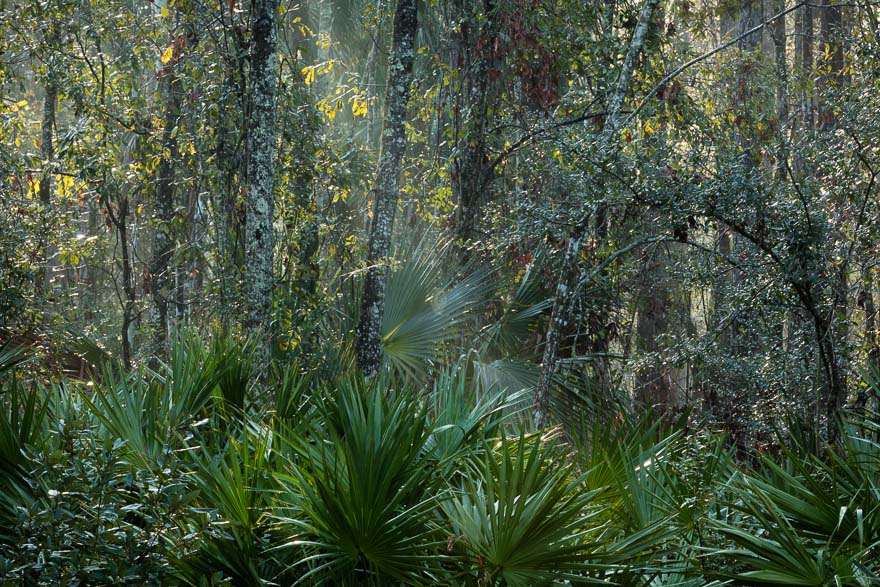Today was cold, I mean really, really cold for December in Florida. I put on everything I owned as I headed to the Kenwood boat ramp near Interlachen Florida. Earlier, a note from my guide, “Ok. I'll meet you at 7am December 6th. Do you know where the ramp is? My number is xxx-xxx-xxxx. The phone may not work out there so be sure you know where you are going before you get out there.” Per Google, the location is 2 hrs from my house, leave at 5, up at 4. Ouch. Did I know where I was going? Not really, never been there in my life. Ok, add another 20 mins for getting lost, which has happened before.
One month earlier. I have always wanted to photograph the Ocklawaha River basin during a period known as the drawdown. Every 4 years, the state lowers the water in the reservoir impounding the river to “flush the toilet” - to remove the accumulating vegetation in the lake. The Rodman Dam, built in 1968, is a relic from the failed Cross Florida Barge Canal, and an environmental disaster crippling one of the most scenic rivers in Florida. When the water is lowered, the remains of a great cypress forest is revealed, hundreds of thousands of stumps rise from the ground like tombstones, forming an unearthly landscape of death. I wanted to photograph what I had imagined to be an apocalypse frozen in time and hidden from view.
I had known about the drawdown and the forest for many years, but you needed boat access to get to the viewing areas. I remembered driving around the Ocala National Forest which borders the river, but could never find a place that I could access a view. This was going to be the time.
I contacted my friend, artist and naturalist Jim Draper who referred me to Karen Chadwick, a local river guide and artist, and advocate for freeing the river for many years. “Karen knows the river and can take you where you need to go.” After an email exchange I was booked for a tour. Unfortunately I couldn’t specify the weather, but it all turned out to be perfect, as it usually does.
I arrived at the boat ramp at the appointed hour, and as Karen was backing her boat into the water. I offered some help, but it was obvious that Karen had things totally under control. She told me to hop on board. Karen didn’t say much, other than commenting about the cold weather. She said the wind chill was probably in the 20s as we proceeded up the canal portion of the river. The sky was dark purple and I could see the sun beginning to make an appearance on the horizon.
December Morning
I explained that I was interested in the trees, or what was left of them. Karen referred to the “drowned forest” and pointed to the right. In the distance I could see the faint outlines of thousands of poles sticking out of the ground. I had to think for a moment about what I was seeing. The scene was unfolding as the sun was rising and the light filled the darkness covering the shoreline. I still had not taken a shot with my camera as I stood there mesmerized by the skeletons of trees. The boat slowed, as Karen prepared to turn, “we have been in a canal that parallels the river and now we will enter the original river basin. Have you been here before?” “No” I sheepishly responded. “Then welcome to the Ocklawaha” Karen announced as she swung the boat around and we started moving in the channel. I told her to stop. I recorded this image, hoping that it would somehow make it in the low light.
Welcome to the Ocklawaha
We continued and mist rising from the warm water made the scene more mysterious and compelling. Then the sun broke through and illuminated the trees with golden light. The birds and fish were everywhere, life among the lifeless. I asked Karen to stop again, then waved her on, and then we stopped, and soon she knew when I saw something to photograph. It was good teamwork. Karen pointed out so many details that could be observed from the ruins. Like an archaeologist in Rome, Karen identified different trees and different configurations, old growth remnants, living trees, and her favorites. Then I learned more about the history of the area, and of the canal, and the ongoing fight to decommission the dam. It turns out that the reservoir is internationally famous for bass fishing, but its long term success is debatable. Nonetheless, there are significant commercial interests in having the reservoir intact.
Cypress Graveyard
For miles we traveled upstream, each turn revealing more of the same. We passed several sites where freshwater springs were located. With the reservoir full, these springs do not flow, but come to life during the drawdown. As we continued, the landscape changed. Some areas had been cleared, some areas burned, some areas “crushed” by a giant mechanical crawler, and some just left to drown. The water level of the reservoir decreases as one moved north, so the stumps were shorter. Then you began to see more surviving trees, or should we say barely surviving. The water levels prevented any new seedlings to survive, and any trees that did somehow persist they did so under torturous conditions, the trunks grotesquely deformed and branches sickly.
Marker 71
Remarkably, even after 50 years of empoundment, the original river channel was clear. We continued for another few miles and then I knew it was time to turn back (yes I was physically and emotionally burned out). We arrived back at the boat ramp at 1. A life changing trip to be continued…
The project page can be viewed here.























































